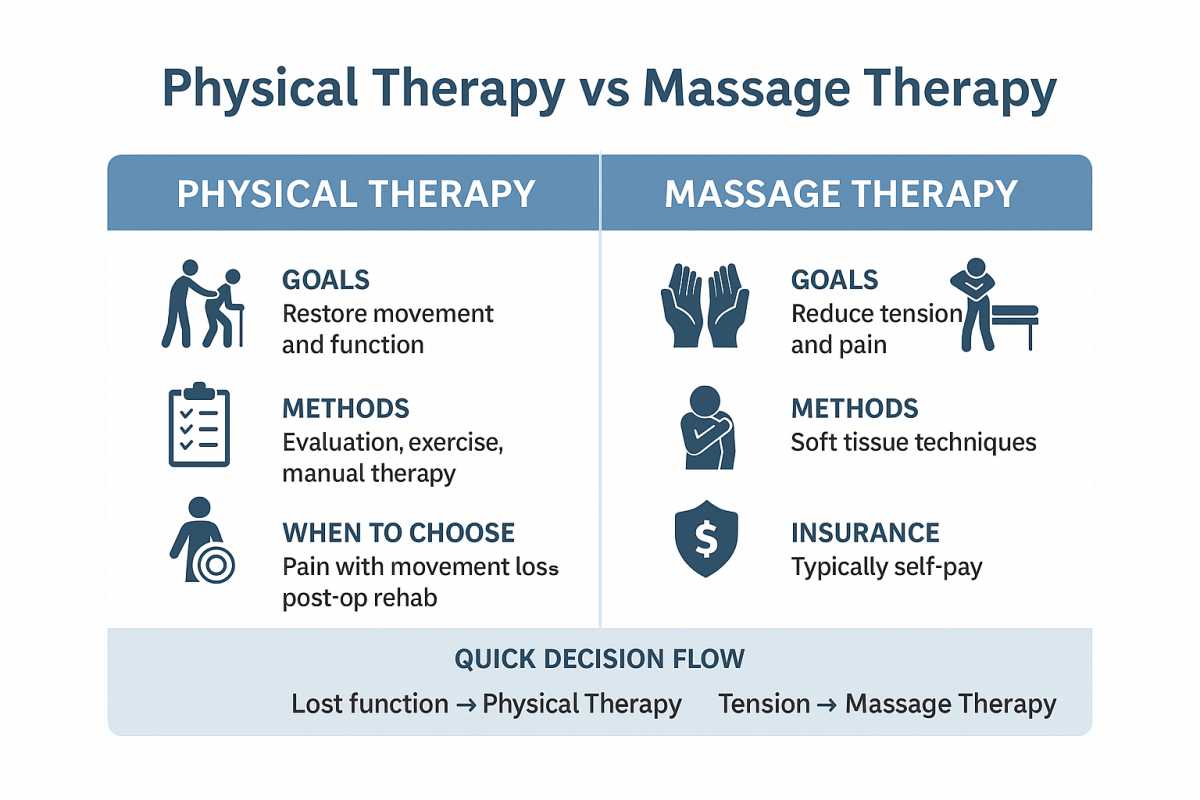Choosing between physical therapy (PT) and massage therapy (MT) can feel confusing—especially if you’re dealing with pain, tightness, or a nagging injury. Both involve hands-on care, but their goals, training, and insurance coverage differ in important ways. This guide breaks it down in plain English, with New York–specific notes so you can book the right first step.
Quick definitions (what each one is)
Physical therapy is a licensed health profession focused on restoring movement and function, reducing pain, and preventing future injury through evaluation, exercise, manual therapy, and education. PTs are trained movement experts who assess the root cause and design a plan of care (often including home exercises).
Massage therapy is also a licensed profession in New York. It uses structured soft-tissue techniques (e.g., Swedish, deep tissue, myofascial) to relieve tension, reduce stress, and support comfort and well-being. In NYS, using the title “massage therapist/masseur/masseuse” requires a license.
Training & licensure in New York (why it matters)
In New York, both PTs and MTs are licensed by the NY State Education Department (NYSED), and you can verify any license online:
Physical Therapists (requirements, renewal, verification). op.nysed.gov
Massage Therapists (requirements, renewal, verification).
Why check licensure? It’s your safety net—ensures training, ethics, and accountability. If you’re unsure where to start, verify the provider and ask about experience with your specific condition (e.g., low-back pain, post-op care, sports injury).
Goals & methods (how care looks day-to-day)
PT typically aims for function: restoring range of motion, strength, balance, and daily activities. Expect an exam, a diagnosis or functional problem list, a progression of therapeutic exercise, and—when indicated—manual therapy or other adjuncts.
Massage typically aims for relief: reducing muscle tension, stress, and perceived pain via hands-on techniques. Sessions are usually 30–90 minutes, focused on relaxation or specific tight areas. NCCIH
Think of PT as plan + progression (you do homework and re-tests), and massage as session-based relief that can complement rehab or stress management.
What does the evidence say?
For common issues like low-back pain, modern guidelines emphasize active approaches (stay active, graded exercise), sometimes combined with manual therapy. Early, guideline-based PT can improve function for recent-onset back pain, and chronic back-pain guidelines consistently recommend therapeutic exercise with selective use of manual techniques.
Massage therapy can reduce short-term pain and anxiety for some conditions, with generally low risk when performed appropriately, but outcomes vary and evidence is mixed; it’s often best used alongside exercise-based care rather than instead of it.
Safety & contraindications (when to pause)
Massage is usually safe, but rare complications have been reported, especially with vigorous deep-tissue work or in higher-risk clients (e.g., bleeding disorders, acute DVT, fractures). If you have red-flag symptoms (new numbness/weakness, fever with back pain, cancer history with new bone pain), seek medical evaluation first. PTs screen for these red flags during evaluation and refer out when needed.
Insurance & cost
PT: Often covered by health insurance when medically necessary and provided by a licensed PT; you may need a referral depending on plan, deductibles, or visit limits.
Massage: Frequently self-pay unless prescribed and billed under specific benefits; some plans exclude it or limit to certain diagnoses/providers.
Always confirm coverage & fees before you book, and ask for a written cancellation policy.

Use-case map: which one first?
Choose Physical Therapy when you need:
Assessment of pain with movement loss or weakness (e.g., shoulder impingement, ankle sprain, knee pain).
Post-surgery or post-fracture rehab.
Recurrent pain that flares with activity and affects function (stairs, lifting, sport).
A structured return-to-work/sport plan plus home exercise.
Choose Massage Therapy when you want:
Stress relief and global muscle relaxation.
Short-term relief of tightness/knots without functional limits.
A complementary session between PT visits to manage tension while you continue active rehab.
Best of both: Many people benefit from PT as the plan and massage as an adjunct for symptom relief, especially early on.
NYC-specific tips
Verify your provider on NYSED before booking (PT or Massage). Save the license number. op.nysed.gov
If you’re unsure where to start or cost is a barrier, talk to your primary care provider about PT options; if stress and muscle tension are primary, start with a licensed massage therapist and switch/coordinate as needed.
Looking for broader mental-health resources while you rehab? See our Therapy NYC hub for crisis links and low-/no-cost programs.
The bottom line
PT = function-first with exercise + education (and manual care when indicated).
MT = relief-first with hands-on soft-tissue work.
For pain that limits activity—or after injury/surgery—start with PT. For stress-dominant tension without loss of function, massage may be enough. You can also combine them thoughtfully.
Mini-FAQ (add as FAQPage schema)
Is massage therapy ever a substitute for PT?
Sometimes—for stress-dominant muscle tension without functional limits. If pain changes how you move (limping, guarding) or follows injury/surgery, start with PT. Evidence for chronic pain consistently supports exercise-based approaches, with manual techniques as adjuncts. jospt.org
Can I do both at the same time?
Yes. Many patients combine PT (plan, progression) with occasional massage (symptom relief). Coordinate scheduling so massage doesn’t replace your home exercise or follow-up testing.
How do I check a provider’s license in New York?
Use NYSED online verification for Physical Therapists and Massage Therapists; save the license number before you book.
Any red flags for massage?
Active blood clots, uncontrolled bleeding disorders, fractures, severe osteoporosis, or new neurologic symptoms warrant medical clearance. When in doubt, ask your clinician first.
Disclaimer: This guide is informational and not medical advice. If you have severe or worsening symptoms, seek an evaluation from a qualified clinician.
